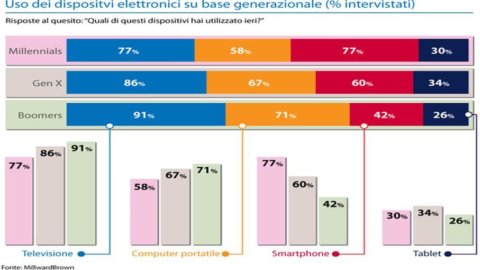The narrowing of the digital divide between generations
In an era where the number of identification linked to Internet is growing so exponential, smartphones and tablets have gradually begun to steal space from PCs and laptops, even if the generational differences continue to affect very on choice of the device mobile by users. L'age, in fact, is among the responsibilities factors which underlie thedigital divide”, or the gap between those who have the possibility of accessing digital technologies and those who cannot do so for a variety of reasons, often of a socio-economic nature.
Until a few years ago the differences seemed immense, perhaps unbridgeable, yet this sort of inequality technological began to shrink faster and faster and even older age groups have begun to explore the world of the web, with curiosity and with remarkable agility. Just think of Skype, which has become part of everyday family life, quickly and cheaply connecting grandparents, grandchildren and parents all over the world.
In short words, not I am more solo i young and the very young a claim the support of technologies of the latest generation, today indispensable for almost all of us. Nonetheless, there continue to be some differences in way in which i digital natives and generations previous they use gods mobile devices for inquire about, have fun, learn and shop. It is interesting to know what these differences are in order to serve each one with the right content.
The Millward Brown investigation
In this regard, a survey conducted by Millward Brown – company of WPP group (the largest multinational advertising and public relations company) – specializing in media and communications and the second largest statistical research and analysis organization in the world after Nielsen.
Millward Brown in October 2014 conducted asurvey on a sample of 1018 respondents resident in USA between 16 and 69 years of age who consume on a daily basis content su smartphone and / or tablets. The investigation wants profile the audience in relation to the device type used so that it can optimize il content for the suitable medium of distribution (which today is a screen of different sizes).
Millward Brown analysts have divided the audience into three age groups (base 2015): the millennial generation including those born after 1980, aged between 18 and 34; there generation X, those born between 1965 and 1980 who are between 35 and 50 years old; there boomer generation which includes those born between 1946 and 1964, now between 51 and 69 years old.
Millennials = smartphones
As revealed by the Millward Brown investigation, a factor of primary importance, in to determine le preferences of the different generations, it seems to be the size the screen. Persons between the ages of 18 and 35, the so-called “millennials", they prefer the smallest one of the smartphone, especially since this type of device is very easy to carry around. Generation Y, whose socialization is largely linked to technology, yes entrust Than we heavily to the smartphone and is often also referred to as the “mobile first generation”. This term refers to need to create content directly in version smartphone (and not in the more complex form intended for other means), optimizing information spaces and striving to stay faithful to the motto "less is more". The simplification , the features are therefore fundamental elements in the design of digital content, especially if we consider the annual growth rate of 25% of web traffic from mobile (in Italy, according to Cisco forecasts, by 2018 there will be almost 350 million di devices connected to Internet, with about 41% di mobile connections and just 6% of CP). Currently, the most popular devices among young people are the Android smartphone (54%) and the iPhone (53%), followed by the iPad (33%), Windows Phone (20%) and Android tablets such as the Samsung or the Kindle Fire (20%).
Generation X = tablets
Unlike millennials, Generation X (those born between 1965 and 1980) is demonstrating to appreciate especially the functionality of the tablets, allowing for rapid diffusion a company level (with the advent of the BYOD philosophy, "Bring Your Own Device", which suggested to companies the idea of experimenting with practical and modern devices originally intended for private users). This category, as well as that of the "over 50s", attaches great importance to quality ofimage and typing, which must be as simple and practical as possible. 55% of users between the ages of 35 and 50 have access to an Android smartphone, 38% to an iPhone, 31% to a tablet, 28% to an iPad and only 9% to a Windows Phone (this latter had to fight quite a bit to make its way into the market, because initially its main competitors offered a much more attractive range of applications and functionalities).
Baby boomers = laptop + television
Confirming the persistence of the generational "digital divide", the "baby boomers" (born between 1945 and 1965), who instead belong to the generation "laptop first”, use the PC to carry out most of the activities. However, this category is demonstrating a growing openness towards new technologies, so much so that the 50% of the baby boomer It owns a smartphone Android or in 37% some cases a tablets, while 24% use the iPhone, 21% the iPad and 8% the Windows Phone. It is also the generation that consumes the most television: 91% of those interviewed identified the small screen as their favorite device.
The information
The habits of different age groups also vary according to the activity to be performed and depend especially on times required: beyond sopra of the 5 minutes even the youngest they prefer il laptop to other screens that are too small in size. THE millennials tend to use the computer to visit blog or to read newspapers and online magazines, while the generation X, which compared to the other categories shows a more frequent use of the tablet, choose often it smartphone to watch the weather and laptop for inquire about about current events and sports or to watch video lesson on the Internet. THE baby boomers, which in most cases prefer the traditional computer, sometimes they also use it smartphone, for example to check the Forecasts of the time. Finally, the three categories of users agree in the choice of laptop when it comes to carrying out research related to health, which obviously requires a lot of time due to the great seriousness and concern with which they are faced.
Entertainment
Le habits of the different age groups yes differ furthermore on the basis of the possible entertainment channels, although the use of content video lesson almost always happen on screens di great size. Many young they visit websites such as YouTube and Netflix (which seem to scale easily to smartphone and tablet sizes), but the 77% of them often watch television. THE boomers definitely lean towards the Cable TV, while not entirely unrelated to YouTube, DVD and Netflix. Again, the generation X proves to be the most versatile in toggling devices: the 61% of people between the ages of 35 and 50 guard la TV almost every day, only that 68% of men also often visit YouTube, against 47% of female frequency.
The e-commerce
Il laptop continues to be a landmark constant in the field of Online shopping, even among young people, although the preferences of users surveyed by Millward vary widely across different product categories. The 31% of the millennials continues to rely mainly on computer for online shopping (especially for financial services, electronics and consumer products), while the 23% use it smartphone and only the 15% il tablets. In 28% of cases, the second band of age uses the laptop to make purchases of all kinds (from cars to telephony), but is starting to switch to smartphone (18%) (for electronics and consumer goods) et al tablets (24%). As for the over fifty, the predominant choice is that of laptop (31%), against 18% for tablets and 13% for smartphones (generally used to purchase consumer goods).
Conclusions
Millward's overview therefore suggests a careful reformulation of the information present in network, which must be reproposed in a way practical e functional on devices of all kinds. However, the practicality of smarphone e tablets not seems to threaten more so the adoption of the classics computer in the context familiar e corporate, due to the higher level of comfort that only i big screens I can offer. In any case, the future looks inevitable integration and coexistence of devices di different kindas well as the progressive dejection of the fence (of the generational ones and hopefully also of the economic ones) which still prevent a large portion of the world population from benefiting from the numerous advantages of technological and digital development.





